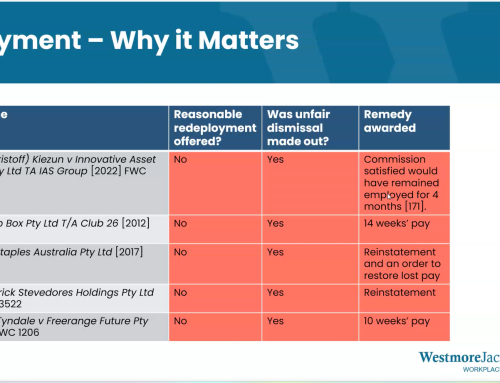
Two weeks ago the Full Bench of the Fair Work Commission (‘Full Bench’) handed down Khayam v Navitas English Pty Ltd
What is a maximum-term contract?
Maximum-term contracts are employment contracts where an employee’s employment is stated to end at a particular time (for example after 1 year), but either party has discretion to end the contract earlier with the giving of notice.
Maximum-term contracts are different from other so-called fixed-term contracts where a start and end date are specified and the parties cannot terminate before the end of the term. Some fixed-term contracts do not allow the parties to end the contract with the giving of notice. Unlike maximum-term contracts, if an employee is dismissed mid-way through these fixed-term contracts, they may be entitled to be paid out the full term of the contract.
At the employer’s initiative: when is someone dismissed?
For an employee to be protected from unfair dismissal he or she must have been dismissed. An employee will have been dismissed if their employment was terminated at the employer’s initiative. That is, if the employer does something which brings an employee’s employment to an end.
Before Friday 8 December 2017
Prior to the Navitas decision, the non-existence of a dismissal of a maximum-term employee at the end of a contract’s term was fairly clear-cut. The former Australian Industrial Relations Commission in Justice v Lunn made clear that where a maximum-term employee’s employment ends when their contract expires there is no dismissal.
Lunn was authority for the proposition that there was no dismissal because the employer had done nothing to effect the ending of the employee’s employment. The employment was simply ended by the passage of time. Lawyers often refer to this as the contract ending through the effluxion of time.
This principle made it difficult for maximum-term employees to be eligible to make an unfair dismissal claim when their employment ended at the expiry of a contract. In most cases this ineligibility was clear, predictable, and relatively easy to ensure. Navitas changes this.
Navitas
Navitas concerned an English-language teacher who was employed on a series of maximum-term contracts. Prior to the expiry of his last contract the employee was informed that Navitas would not be offering him further contracts. His employment ended with the expiry of his last maximum-term contract.
At first instance, the employee was held to be ineligible to make an unfair dismissal claim as he had not been dismissed. Applying Lunn, Commissioner Hunt held that the employee’s employment was terminated by the passage of time. Not by Navitas.
The employee appealed.
Appeal decision
On appeal, the Full Bench overturned a number of principles for which Lunn was authority. The new principles in Navitas can be found at paragraph [75] of the decision.
Most importantly, the Full Bench held that only when the terms of a maximum-term contract “reflect a genuine agreement that the employment relationship (as opposed to a particular contract of employment) will not continue after a specified date” will the passage of time effect the ending of the employment relationship.
Absent this genuine agreement the passing of time will not necessarily be the thing which ends an employee’s employment. Without a genuine agreement, the employee may be held to have been dismissed (and therefore eligible to make an unfair dismissal) at the expiry of the contract.
If there is no genuine agreement, a failure by an employer to offer a further contract simply becomes one factor of many which is considered by the Commission in an attempt to decide whether the employer performed any action which was the principal factor in terminating the employee’s employment. That is, the expiry of the contract, of itself, is no longer decisive.
The significance of Navitas is that in certain circumstances a maximum-term employee will have access to unfair dismissal when their employment is ended by the employer at the expiry of their contract. No longer is it certain that an employee will not be able to seek an unfair dismissal claim at the end of the expiry of their maximum-term contract.
Uncertainty
How the Full Bench’s new test is applied is yet to be seen. The Full Bench remitted the decision back to Commissioner Hunt to determine in light of the new law.
What is required to create a genuine agreement regarding the ending of an employment relationship (and not just a contract of employment) is also unclear.
Whether the reasoning in Navitas would withstand a possible appeal is also uncertain. The Australian Industry Group, the Australian Chamber of Commerce and Industry, and the Australian Council of Trade Unions all made submissions in Navitas. An appeal of Navitas is possible.
Alternatively, the new test in Navitas may be challenged in other cases which come before a full bench of the Commission.
Implications for employers
Many employers use maximum-term contracts as they provided security and flexibility. This may no longer be the case. Pending subsequent cases which give us guidance as to how easy (or difficult) a genuine agreement is to make, the protection (if any) that maximum-term contracts gives employers from unfair dismissal claims is uncertain.
In the wake of Navitas the only certainty regarding maximum-term contracts is uncertainty. The law of maximum-term contracts is in flux. Employers who employ large numbers of employees on maximum-term contracts should consider seeking legal advice regarding this method of employment.
Adam Colquhoun, Principal, WestmoreJacobs
This article is general information only. It is not legal advice. If you need legal advice, please contact us.






Leave A Comment